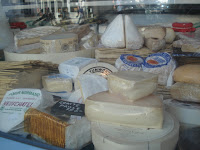1. Infinity Foods
|
|
Infinity Foods is a Brighton institution since decades in the Brighton North Laines. A whole vegetarian supermarket with an eco-friendly approach and plenty of local products. Here you can find almost anything in a normal supermarket with very competitive prices, such as vegetables, fruit, cookies, pasta, wines and even toilet products and shampoo. Also in the bakery you can have a delicious takeaway slice of vegetarian pizza.
Follow all our Nutrition news and take a look at our Sea-salt guide
Follow all our Nutrition news and take a look at our Sea-salt guide
2. Grocer & Grain
|
|
Grocer & Grain is a smart shop located very close to the Brighton train station that makes it very handy for grabbing some healthy snacks before your journey or grab a last moment gift. They offer plenty of organic products including local cheeses and hams, homemade cakes or pies, Ecover products and my favourite organic yellow tea brand and always vegetables and flower are excellently displayed.
 |
| Taj street display |
Try make Gazpacho with fresh red organic tomatoes from Taj
4. Steamer
If you need appliances for your kitchen Steamer is your place, the kitchenware specialist in Brighton are in Ship Street. From Kitchenaid appliances, pans, LSA glasses and everything that you need for baking and cooking. The products aren’t cheap but the quality is superb.
5. The Brighton Sausage Company
|
|
Also in the Brighton North Laines The Brighton Sausage Company offer to you a range of gourmet sausages like the already traditional flavour with leek and apple to more exotic like curry or jalapeños, flavours. They also have chicken and game sausages, eggs, and even Mexican chorizo. Their own make sausages use local meat from farms around.
Try: Three English Sausages clever recipes
Try: Three English Sausages clever recipes
6. La Cave à Fromage
|
|
La Cave à Fromage is one of the best cheese shops speaking in selection and quality terms that you can find in the whole of England. This cheese lovers paradise offers of course a wide selection of the best French cheese but also the best that UK can offer. And it wasn´t a surprise to find the world wide famous Cabrales cheese from Spain. The low point is the lack of labelling and the service is a bit slow, another French touch if you want it.
Try: Chicory salad with Mimolette Cheese
Try: Chicory salad with Mimolette Cheese
It’s a shame the Butchers shops are in decline in almost whole of Europe; in Brighton they are living a revival when you can find several options. My local Butcher are Canham & Son they have superb quality meat from the best cattle that grass in the Southdown’s Natural park area, beautiful pieces of Scottish meat and always plenty of seasonal turkey, pheasants and another birds. I know that the customer service is excellent but the butchers don’t like to much be asked for weird Argentinian cuts like I used to do sometimes.
Try: Steak with Fig salad
Try: Steak with Fig salad
8.
Ten Green Bottles
|
|
Plenty of places to get your booze in Brighton but no one like Ten Green Bottles; they personally are picking the best of the new European wines. For me was a very nice surprise to find the Urabain red wines from Navarra. Navarra is a not too well known area for such wines but they make excellent beverages. And if you want to discover why the Rheinhessen withe German wine are getting every year more popular here you will find some good bottles. The shop also has a wine bar where you can try before to buy, the food isn´t great.
9. Thorne´s
|
|
The last gourmet shop to arrive, if I need to make a list which is the best gourmet shop in Brighton then to be sure they will be on the top. Thorne´s seems like they pick the best of all the shops mentioned above. The butcher has high quality local meat, tasty sausages and excellent customer service. Bread and croissants are crunchy, delicate and tasty. Also a selection of local beers, ciders and organic apple juice, you really need to try it. Very seasonable vegetables and even organic fair-trade coffee from Guatemala. The shop design is superb and if you have not enough you can have a chef breakfast upstairs (also are open for lunch)
Try: How to prepare the perfect pan fried steak
Try: How to prepare the perfect pan fried steak
10. Brighton & Newhaven Fish Sales
 |
| Fish get very busy Friday and Saturday morning with Brightoners |
When I moved to Hove every time that I tried an excellent fish dish in Brighton I discovered that the source was all the same: The Fish shop in hove lagoon. They provide the whole city with the most fresh and local fish and seafood at very good prices. One mussels kilogram less than 3 pounds, local sea bream, red mullet, crabs, lobster, dover sole and a little fish deli with sauces, frozen fish and even pasta. The customer service is quick, efficient and very clean, and you can follow the catch of the day on Twitter!
Try: Sea Food Pasta using Fish products
*Please notice I am just a regular client but I don’t have any relationship with the owners
Try: Sea Food Pasta using Fish products
*Please notice I am just a regular client but I don’t have any relationship with the owners
































